Innovative Cardiac and Vascular Surgical Procedures
Cardiovascular surgeons at THI perform innovative surgical procedures. They are supported by cardiac anesthesiologists, perfusionists (specialists who operate a heart-lung machine during cardiac surgery), specially-trained operating room nurses and heart team lab technicians and clinicians. This team performs delicate surgical procedures on a regular basis, bringing a high level of skill and experience to every case. As a result, many patients are able to go home in less than five days following open-heart surgery.
Get a Physician Referral
If you need a referral to a cardiovascular surgeon, cardiac specialist or other physician at Texoma Medical Center, call our free physician referral service at 903-416-3627.
Cardiothoracic Surgery
These surgeries involve the heart, lungs and other organs in the chest. Early detection and proactive treatment can help reduce the chance of heart damage. Cardiothoracic surgeries include:
- Beating Heart Bypass – During beating heart bypass surgery, cardiac surgeons operate while a patient's heart continues to pump blood through the body. This can reduce the risk of complications for patients with certain medical conditions. With backgrounds in cardiac and vascular surgeries, the team employs innovative surgical procedures including “off pump” beating heart surgery.
- Mitral Valve Repair – Surgery to repair your mitral valve may be needed if it is too hard (calcified), which could prevent blood from flowing through the valve, or if it is too loose, which could cause blood to flow backward through the valve.
- Aortic Aneurysms and Dissections Repair – An aortic aneurysm is when the wall of the aorta bulges or balloons, which could then burst. A dissection is when the inner wall of the aorta tears.
Patient testimonial: Danny and Sheri Merriman
 Married couple Danny and Sheri Merriman both suffered cardiac issues that required multiple heart bypasses. After six days of recovering from his procedure, Danny was cleared to return home. “The ICU nurses and doctors are a super bunch,” he says. Sheri spent four days recovering in the hospital before she was released. “The physical therapists had me up and moving 12 hours after I woke up from surgery,” she recalls.
Married couple Danny and Sheri Merriman both suffered cardiac issues that required multiple heart bypasses. After six days of recovering from his procedure, Danny was cleared to return home. “The ICU nurses and doctors are a super bunch,” he says. Sheri spent four days recovering in the hospital before she was released. “The physical therapists had me up and moving 12 hours after I woke up from surgery,” she recalls.
Endovascular Surgery
This type of minimally invasive surgery enables surgeons to access many regions of the body through major blood vessels. Endovascular surgeries include:
- Endovascular Repair of Abdominal and Thoracic Aortic Aneurysms – An abdominal aortic aneurysm occurs in the part of the aorta that runs through the abdomen, while a thoracic aortic aneurysm occurs in the chest.
- Atherectomy – An atherectomy is a minimally invasive procedure performed to remove plaque and fatty deposits (atherosclerosis) from your artery walls, which can restrict blood flow.
Open Vascular Surgery
Vascular disorders can disrupt blood flow due to atherosclerosis. This can result in stroke, kidney failure, limb ischemia or even death. Open vascular surgeries include:
- Ascending and Thoracic Aortic Aneurysm Repair
- Abdominal Aortic Aneurysm Repair
- Carotid Endarterectomy – During this procedure, surgeons remove plaque buildup in your carotid artery and restore normal blood flow to your brain.
- Peripheral Bypass Grafts – This surgery is performed to replace or bypass part of an artery that is blocked.
- Open Embolectomy and/or Thrombectomy – An embolectomy is the removal of an embolus, which is part of a blood clot that has broken away and is now moving through your body. A thrombectomy is the removal of a thrombus, or stationary clot. Both clots can be very dangerous, even leading to death.
